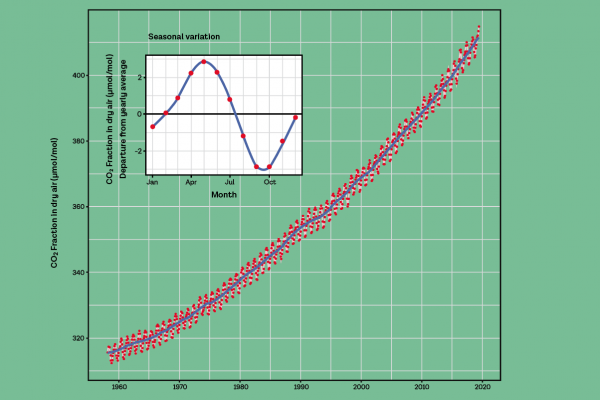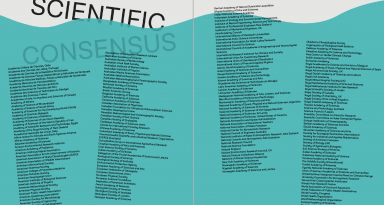The current warming trend is of particular significance because most of it is extremely likely (greater than 95 per cent probability) to be the result of human activity since the mid-20th century and proceeding at a rate that is unprecedented over decades to millennia.
Earth-orbiting satellites and other technological advances have enabled scientists to see the big picture, collecting many different types of information about our planet and its climate on a global scale. This body of data, collected over many years, reveals the signals of a changing climate.
The heat-trapping nature of carbon dioxide and other gases was demonstrated in the mid-19th century. Their ability to affect the transfer of infrared energy through the atmosphere is the scientific basis of many instruments flown by NASA. There is no question that increased levels of greenhouse gases must cause the Earth to warm in response.
Monthly mean CO2 concentration Mauna Loa 1958 – 2019

Data: R.F. Keeling, S.J. Walker, S.C. Piper and A. F. Bollenbacher Scripps CO2 Program.
Global Temperature Rise:
The planet's average surface temperature has risen about 1.62 degrees Fahrenheit (0.9 degrees Celsius) since the late 19th century, a change driven largely by increased carbon dioxide and other human-made emissions into the atmosphere. Most of the warming occurred in the past 35 years, with the five warmest years on record taking place since 2010.
Warming Oceans:
The oceans have absorbed much of this increased heat, with the top 700 metres (about 2,300 feet) of ocean showing warming of more than 0.4 degrees Fahrenheit since 1969.
Shrinking Ice Sheets:
The Greenland and Antarctic ice sheets have decreased in mass. Data from NASA's Gravity Recovery and Climate Experiment show Greenland lost an average of 286 billion tons of ice per year between 1993 and 2016, while Antarctica lost about 127 billion tons of ice per year during the same time period. The rate of Antarctica ice mass loss has tripled in the last decade.
Sea Level Rise:
Global sea level rose about 8 inches in the last century. The rate in the last two decades, however, is nearly double that of the last century and is accelerating slightly every year.
Extreme Events:
The number of record high temperature events in the United States has been increasing, while the number of record low temperature events has been decreasing, since 1950. The U.S. has also witnessed increasing numbers of intense rainfall events
Ocean Acidification:
Since the beginning of the Industrial Revolution, the acidity of surface ocean waters has increased by about 30 per cent. This increase is the result of humans emitting more carbon dioxide into the atmosphere and hence more being absorbed into the oceans. The amount of carbon dioxide absorbed by the upper layer of the oceans is increasing by about 2 billion tons per year.
Source: NASA’s Jet Propulsion Laboratory
< Scenario 3 | Making the world >




































